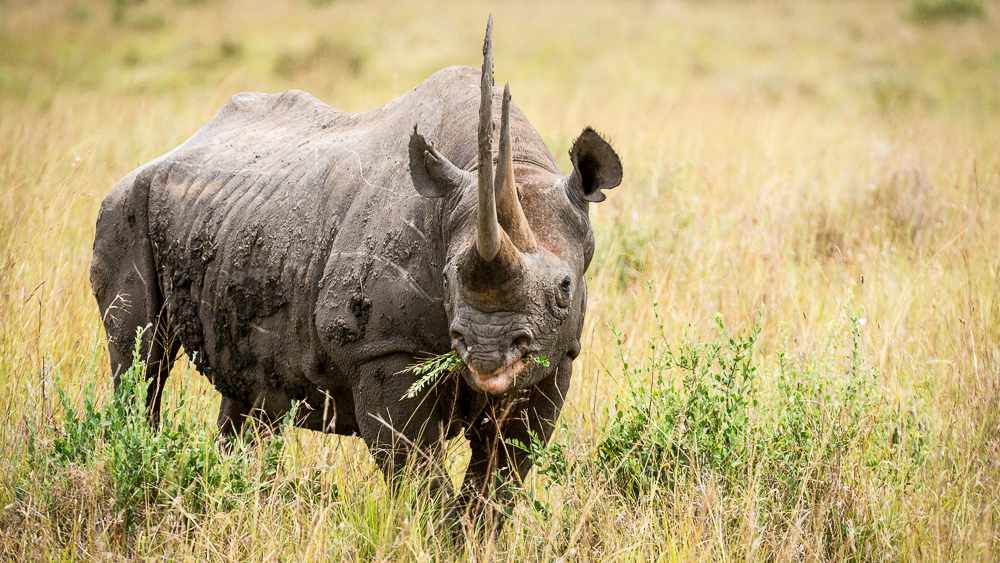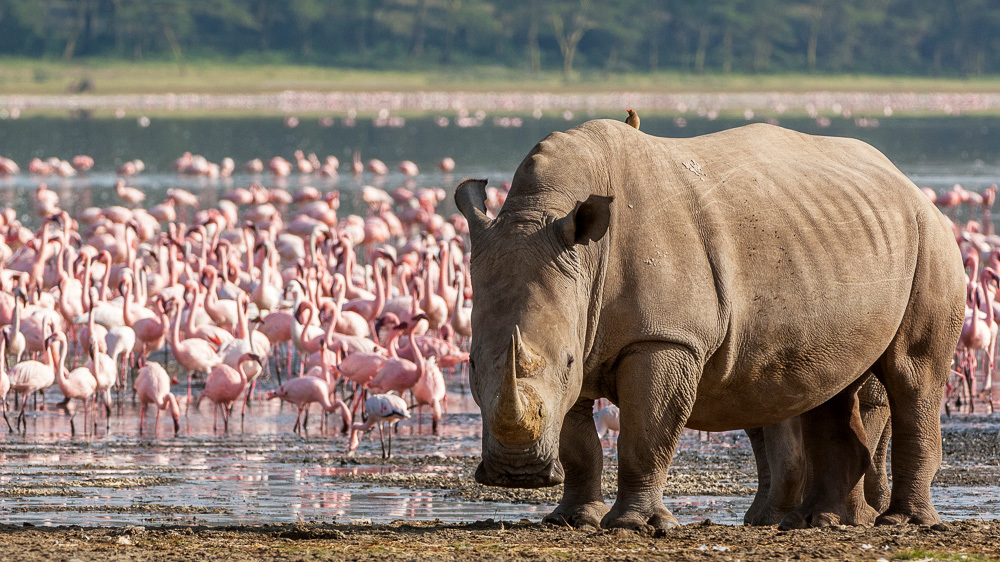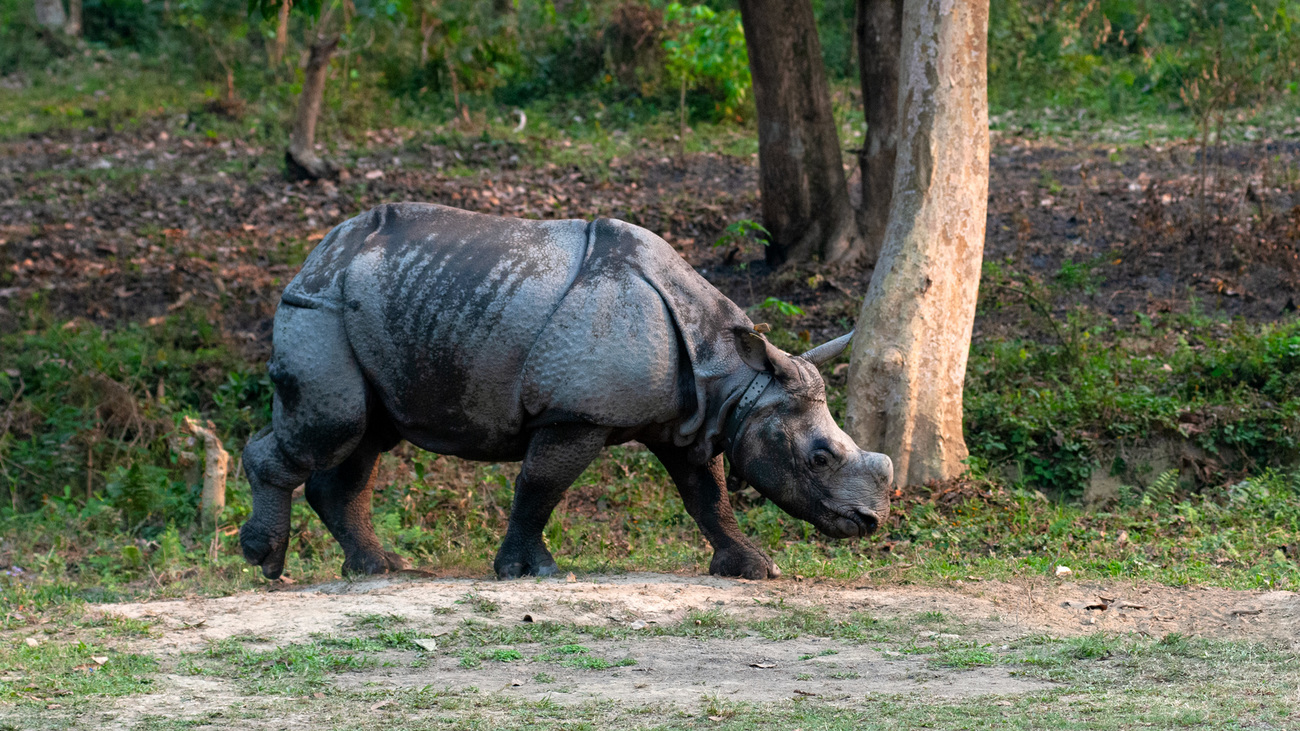Greater Manas Landscape Conservation - India
By restocking and enlarging a park, we restored its natural heritage and brought back the one-horned rhinoRhino poaching: Why it’s a big problem
Rhino poaching: Why it’s a big problem
Despite conservation efforts, poaching is a constant threat to rhinos. These impressive mammals are targeted for their horns—a demand driven by lucrative black markets—and are being poached to near extinction. This not only threatens rhino species’ survival but also has wider impacts on the environment and biodiversity of their habitats.

In this article, we cover the basics of what poaching is, why rhinos are poached, the impacts of rhino poaching on the environment, and how you can help protect rhinos.
IFAW is a global conservation organisation that works to protect animals around the world, including rhinos. To learn more about our work protecting and rescuing rhinos in India and Africa, check out our projects page.
What is poaching?
Poaching is an illegal practice in which wildlife is captured or hunted. Poachers often target animals for their body parts, such as meat, tusks, skin, or—in the case of rhinos—their horns. The illegal activity also involves capturing live animals for illegal trafficking, either for the exotic pet trade or for exploitative purposes like entertainment and tourism.
If a species is protected by law then the taking of that animal is considered poaching. This also encompasses plants, such as trees that are harvested for timber, or other plants that are poached and traded for decorative purposes. Maritime law states that illegal fishing and hunting in water is also a form of poaching, including everything from hunting protected fish species to overfishing past quotas and fishing in restricted areas.
The illegal nature of poaching means it often occurs in remote areas where it can be challenging to enforce wildlife protection laws. The consequences of poaching are far-reaching, impacting not just the targeted species but also entire ecosystems and local communities that depend on wildlife tourism for their livelihoods.
Why are rhinos poached?
Rhinos are targeted by poachers for their horns. These are particularly sought after in some cultures for their supposed medicinal properties and the perceived status of wealth they bring.

Though rhino horn is made from keratin—the same protein as human hair and nails—it is believed to have medicinal properties that cure hangovers, fevers, and even cancer. Despite scientific evidence debunking these claims, their demand remains high, particularly in parts of Asia. This demand drives a lucrative black market, leading to the ongoing slaughter of these animals.
To meet market demands, poachers use sophisticated equipment to track down and kill rhinos. They normally use a tranquiliser gun to knock out the rhino, before hacking off its horn. The mutilated rhino often bleeds to death as a result.
Where is rhino poaching a problem?
In South Africa, rhino poaching is a growing problem. In 2023, an estimated 499 rhinos were hunted in the country, compared to 448 the year before. A newly published report by Center for Advanced Defense Studies (C4ADS) in 2024 reported that 46.6% of recent rhino horn seizures by authorities originated from South Africa.
However, rhino poaching isn’t restricted to just one country. It affects all rhinoceros species around the world, each facing unique threats from poachers.
Black rhinos
Black rhinos (Diceros bicornis) inhabit regions of Africa where political instability and lack of resources exacerbate the poaching crisis. Between 1970 and 1992, the population of black rhinos dropped by a drastic 96%, leaving a mere 2,400 individuals. This steep decline was largely driven by poachers that were hunting rhinos for their horns. Poaching has contributed to the extinction of one black rhino subspecies.
As of 2023, there are an estimated 6,487 black rhinos in the wild, reported by the IUCN. Poaching is still their biggest threat. It’s estimated that about 95% of rhino horn sourced from Africa for trafficking to Southeast Asia comes from black rhinos. Since 2007, rhino poaching has greatly increased, and it peaked in 2015, when 1,349 rhinos were killed in Africa. Over the past few years, despite poaching, black rhino numbers have been on the rise.
In 2022, an estimated 561 rhinos were killed in Africa, including black and white rhinos.
White rhinos
White rhinos are found today in sub-Saharan Africa. The white rhino population has also been largely impacted by poachers, with the species listed on the IUCN Red List as near threatened. There are two subspecies of white rhino, the southern white rhino (Ceratotherium simum simum) and the northern white rhino (Ceratotherium simum cottoni). Poaching has sadly led to the near extinction of the northern white rhino. There are only two female northern white rhinos left in the world, living in a sanctuary in East Africa.
Southern white rhino populations are fortunately growing. As of 2023, it’s estimated that there are about 16,803 southern white rhinos remaining in the wild.

Sumatran rhinos
The Sumatran rhino (Dicerorhinus sumatrensis) is a critically endangered species, with only around 30 individuals known to inhabit the islands of Borneo and Sumatra. Sumatran rhinos are the smallest of the living rhinos and are the only Asian rhino with two horns.
Many centuries of over-hunting have depleted the Sumatran rhino population, in addition to habitat loss. Today, poaching of the tiny Sumatran rhino population still occurs, but opportunistically rather than in a highly-organised manner as it occurs in Africa.
Javan rhinos
It’s estimated that poachers have killed around a third of Javan rhinos (Rhinoceros sondaicus). Out of a mere population of around 70, it’s thought that 26 of these endangered rhinos have been poached since 2019. Considered to be one of the most endangered species on earth, the Javan rhino species is exclusively found in Ujung Kulon National Park, Indonesia. Unfortunately, there have been signs of increased illegal activity in this area. There are reports that the Government of Indonesia is investigating a recent unnatural death of a Javan rhino.
Greater one-horned rhinos
The greater one-horned rhino (Rhinoceros unicornis), also known as the Indian rhino, is one of the great success stories of conservation efforts.
At the end of 2022, it was announced that zero greater one-horned rhinos had been poached that year, which was a first in 45 years. Sadly, during 2023, India reported two poaching losses in Kaziranga National Park and Manas National Park.
Though they were once widespread across northern India, Indian rhinos almost became extinct in the early 90s, with just 200 remaining. Since then, their populations have increased to over 4,000, a huge success in rhino conservation.

How many rhinos are poached each year?
The number of rhinos poached annually varies by species and region. In Africa, it’s estimated that 561 rhinos were poached during 2022. A large amount of illegal rhino killing occurs in South Africa, with 448 rhinos thought to have been poached in the country in 2022. This number is slightly down from 451 South African rhino poachings in 2021.
In Namibia, rhino poaching almost doubled from 47 in 2021 to 93 in 2022. Poaching levels increased by a staggering 93% there between 2021 and 2022. In Kenya, it’s reported that only one rhino was killed in 2022, down from six the year before. In that same time period, white rhinos saw a population decrease of 24% down to 15,942 individuals, primarily due to poaching.
Despite the ongoing poaching problem in Africa, hope remains. The overall rhino population still increased by an estimated 5.2% between 2021 and 2022.
In terms of each rhino species, poaching does remain a threat to all five of them, with poaching activities increasing in some areas that hadn’t previously been targeted. Unfortunately, the status and location of 12 of the estimated 72 remaining Javan rhinos is unknown. It’s also hard to approximate the number of Sumatran rhinos in the wild, as signs of their presence and activity are becoming increasingly harder to find.
What is the impact of rhino poaching?
Besides impacting the populations of rhino species and subspecies, historically leading many of them to extinction and near extinction, it can also have a critical impact on local ecosystems.
Rhinos are herbivores, consuming large amounts of vegetation which helps to shape the landscape. Their grazing and browsing patterns prevent certain plant species from becoming over dominant, helping to maintain a diverse and balanced ecosystem. Without the rhinos, some plant species may begin to outcompete others, leading to lower plant diversity. This can then have a knock on effect for other herbivores that rely on this plant diversity, which can ultimately impact the biodiversity of the entire food web.
Baby rhinos are also prey to predators such as hyenas and lions. Without this food source, it may affect the health and population of these natural predators, which, again, can impact the whole food chain.
How can we save rhinos from poaching?

Several measures and initiatives have been instituted all over the world to help protect rhino populations. This includes anti-poaching patrols, where rangers and trained professionals monitor protected areas and respond to poaching incidents.
Stricter enforcement of wildlife protection laws is crucial to saving rhinos, where criminals face stricter penalties for poaching and trafficking of rhino products.
Illegal wildlife poaching and trafficking are often enabled by the apps and social media platforms that we use every day. Here, poachers are able to identify buyers and facilitate the illegal trade. But with so much illegal activity occurring online—as well as the anonymity that criminals can often hide behind—tracking them down isn’t easy.
Through our combating wildlife cybercrime project, IFAW has been investigating and preventing wildlife crime online for two decades. Our team has found and taken down thousands of listings selling protected wildlife and their body parts online. We have also advocated for international legal frameworks to tackle wildlife cybercrime, which has seen more than 170 countries agree to a Resolution and Decision to combat online wildlife traffickers. IFAW also supports law enforcement with the necessary resources and information they need to track down this illegal activity.
Beyond that, we partner with online tech companies to help them crack down on online wildlife trafficking on their own platforms. There’s now a coalition of 47 companies working together to prevent and mitigate instances of the illegal trade occurring online. Finally, we encourage conscious consumerism, by educating the public about the consequences of wildlife crime and participating in this trade.
Since 2006, IFAW has been committed to restoring the rhino population of Manas National Park in Assam, India, working with the Assam Forest Department and Wildlife Trust of India (WTI).
IFAW also works to support wildlife rangers in their training, housing, equipment, and overall welfare. These frontline workers are the people who stop poaching and trafficking before it takes the lives of more rhinos.
To help support our efforts and protect rhinos, donate today.
Related content
Every problem has a solution, every solution needs support.
The problems we face are urgent, complicated, and resistant to change. Real solutions demand creativity, hard work, and involvement from people like you.